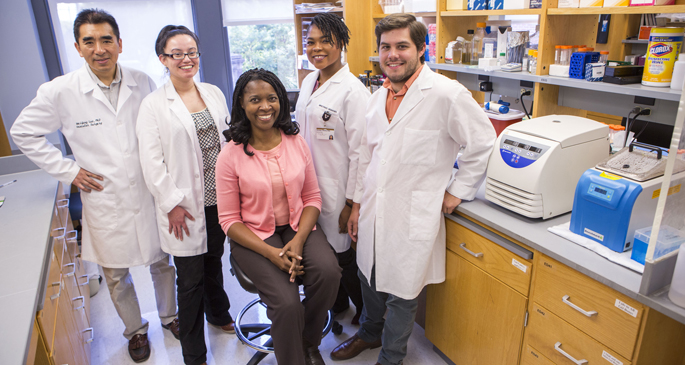
The Vanderbilt Idiopathic Pulmonary Fibrosis Center played a key role in testing the first two drugs approved by the FDA for the treatment of idiopathic pulmonary fibrosis (IPF).
The Food and Drug Administration granted the drugs, Ofev and Esbriet, fast track, priority review and breakthrough designations, approving them ahead of schedule. This came as welcome news to IPF patients for whom there has been no viable therapy to treat their disease.
Idiopathic pulmonary fibrosis is a condition in which the lungs become progressively scarred over time. As a result, patients with IPF experience shortness of breath, cough and have difficulty participating in everyday physical activities.
Prior to the approval of the two new drugs, treatments for IPF include oxygen therapy, pulmonary rehabilitation and lung transplant. There is no cure, and most patients’ prognosis is three to five years survival.
“These are the first two drugs that have ever been shown definitively to have any effect on pulmonary physiology in IPF patients,” said Lisa Lancaster, M.D., clinical director the Interstitial Lung Disease Program and associate professor of Medicine.
Lancaster was one of the authors of the Phase III study of Esbriet that was published in the New England Journal of Medicine.
As part of a network of 10 academic medical centers funded by the National Institutes of Health (NIH) to develop effective therapies for IPF, Vanderbilt was one of the clinical trial centers for both Ofev and Esbriet and was the top enroller for Esbriet.
The drugs have been shown to slow the progression of IPF, but can’t cure it or alter its course, said nurse practitioner Wendi Mason, Interstitial Lung Disease Coordinator.
“It’s a huge first step. Our Center has been participating in randomized clinical trials since the first study in 1999 and we have evaluated at least 20 different drugs for this disease. We finally have some way to slow the progression and this offers hope to people,” she said.
The worldwide clinical trials studied safety and efficacy of the drugs on forced vital capacity — the amount of air which can be forcibly exhaled from the lungs after taking the deepest breath possible.
With both drugs patients cut their lung capacity losses in half. Those on placebo lost about 400 ml of lung capacity while those on the test drugs lost 200 ml over a year’s time.
Because the drugs were fast-tracked, Vanderbilt’s patients gained early access to them.
“When we counsel patients on these drugs we make sure they understand that there is still an expectation of loss of lung capacity over time. Neither of these drugs have been shown to stabilize or improve their condition. We continue to have several promising Phase II randomized drug trials awaiting patient enrollment to determine efficacy. There is still much to learn and much work to do to stop this disease, but we are moving in the right direction and that is exciting,” Mason said.
Ofev and Esbriet are kinase inhibitors that block multiple pathways that may be involved in the scarring of lung tissue. Their safety and effectiveness were established in three clinical trials of 1,231 patients and 1,247 patients with IPF, respectively.
“Vanderbilt has been a leader in IPF since the 1990s when Dr. Jim Loyd started the program, and we’ve been a top enroller in most, if not all, IPF clinical trials since that time,” Lancaster said.
“We’ve still got lots of work to do. The pathways are so broad. We are likely going to need multiple drugs impacting different aspects of the pathway. Vanderbilt is a leader not just nationally but internationally in IPF, both in clinical trials and in bench research. We have many colleagues around the U.S. that we collaborate with as we’re searching to better understand this disease and find possible therapies.”















